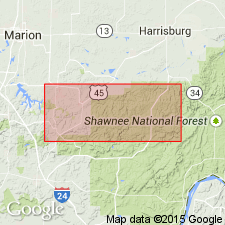
- Usage in publication:
-
- Oldtown Coal Bed
- Modifications:
-
- Named
- Dominant lithology:
-
- Coal
- AAPG geologic province:
-
- Illinois basin
Summary:
Coal bed in the basal Spoon Formation of the study area, exposed in a railroad cut just south of Oldtown, is here named Oldtown Coal Bed. This exposure was miscorrelated with the Delwood Coal Member of the Abbott Formation by Kosanke and others (1960). Palynological study of the Oldtown indicates that it is slightly older than the Delwood and correlates instead with the Rock Island Coal of northwestern IL, the Litchfield and Assumption Coals of central IL, and the Minshall Coal of IN. Thickness up to 36 in. Underlies 4 to 10 ft of medium to dark gray, smooth, well-laminated shale. Overlies 40 to 45 ft of interlaminated, dark gray, silty shale and siltstone and below that approximately 50 ft of thin-bedded sandstone, which is gradational from the underlying Murray Bluff Sandstone of the Abbott Formation. Age of the Oldtown is very late Atokan.
Source: GNU records (USGS DDS-6; Reston GNULEX).
For more information, please contact Nancy Stamm, Geologic Names Committee Secretary.
Asterisk (*) indicates published by U.S. Geological Survey authors.
"No current usage" (†) implies that a name has been abandoned or has fallen into disuse. Former usage and, if known, replacement name given in parentheses ( ).
Slash (/) indicates name conflicts with nomenclatural guidelines (CSN, 1933; ACSN, 1961, 1970; NACSN, 1983, 2005, 2021). May be explained within brackets ([ ]).

